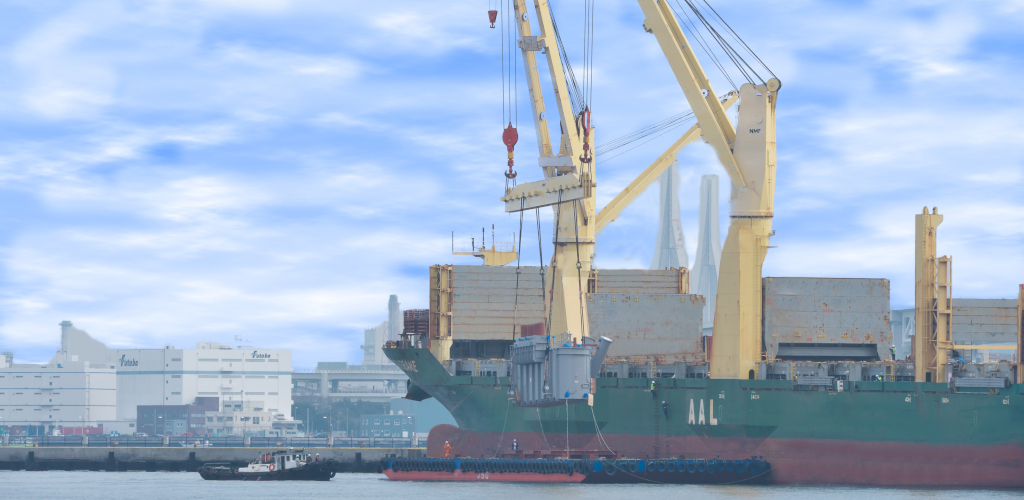Offshore Wind and LNG Projects Driving Demand for Heavy-lift Shipping

By Thomas Timlen
Japan’s ambitious energy targets that include a planned 45 GW of offshore wind capacity by 2040 are sparking excitement among heavy-lift shipping. Industry leaders from BBC Chartering, JSI Alliance and AAL Shipping explain how carriers can position themselves to play a crucial role in the country’s green transformation.
From Issue 4, 2024 of Breakbulk Magazine.
(6-minute read)
Factors including wage growth, consumer spending and a weak yen are, in the second half of 2024, expected to deliver GDP growth for Japan - an increasingly attractive market for those providing heavy-lift and project cargo transportation services.
In February, Swire Shipping returned to Japan - a market Swire first served as long ago as 1867 - with a new branch office in Tokyo. The carrier cited the “vast potential of the Japanese market” and said it was integrating its Westwood brand to create “a unified front for its services in Japan, North America, South Korea and China.” Swire provides specialist shipping services to the global project logistics market under its Swire Projects banner, providing customer solutions for project, heavy-lift, refrigerated, breakbulk and mini bulk cargoes.
“In Japan, there is significant demand for heavy-lift and project cargo transportation services in various sectors,” Peter Roland, BBC Chartering’s managing director in Japan, told Breakbulk. “One notable area is the renewable energy sector, particularly with the construction of wind farms and solar power plants. These projects often require the transportation of large wind turbine components, such as blades, towers, and nacelles, as well as solar panels and related equipment.
“Additionally, infrastructure projects such as bridge construction, building renovations, and industrial plant expansions also require the movement of heavy machinery, steel structures, and oversized components.”
Roland is not alone in pointing towards renewables. “In order to ensure energy security, reduce greenhouse gas emissions and combat climate change, onshore and small-scale offshore wind power projects are being developed, and there is a growing demand for heavy-lift and project cargo transportation services to import equipment such as turbines, blades, and towers for these projects,” said Masahiko Uchiyama, JSI Alliance’s managing director for Japan.
“Due to the demand for wind power-related equipment, the number of our ships calling at Japanese ports for imports has exceeded the number of exports in recent years. This trend is likely to continue for the time being as the Japanese government strives to achieve its greenhouse gas reduction target of a 46% reduction by fiscal year 2030 compared to fiscal year 2013.”
Existing government programs appear to be buttressing the demand generated by the energy sector, as Marc Willim, AAL Shipping’s global head of chartering, explained to Breakbulk. “While the Japanese market has been quiet on the export side, import projects have been steady. Almost all import projects have been wind energy-related.
“As part of the Japanese government’s 6th Strategic Energy Plan, approved in October 2021, it aims to increase the share of renewables in its energy mix to 36 to 38% by 2030, up from 20% in 2021. Wind power currently accounts for around 1% of the energy mix and will therefore need to be scaled up, both onshore and offshore, providing significant opportunity for related cargoes.”
Government’s Ambitious Target
Uchiyama pointed to the Japanese government’s ambitious target of introducing 45GW of offshore wind power by 2040. “This will create a huge demand for heavy-lift and project cargo services to transport the foundations, turbines, etc. for Japan’s offshore wind power projects.”
Another driver for project cargo transportation demand is further expansion in the LNG sector, which has been impacted by conflicts far from Japan. “We also see high demand from LNG projects,” says Uchiyama. “There was already steady demand but further demand has been generated by strengthening energy security and managing geopolitical risks in the wake of the Russia-Ukraine conflict.
“Although there are uncertainties such as the U.S. presidential election, demand for energy remains strong and, as a result, demand for heavy-lift and project cargo transportation services for new projects is also expected to remain high for coming years.”
 In turn, related regional developments can draw in Japanese know-how as Yuko Kimura, AAL Shipping Japan’s managing director, explains. “There are several projects in the pipeline that will call on Japan’s expertise, including power plants in Southeast and North Asia, as well as LNG plant and hydrogen projects in Oceania. These types of projects will require heavy modules, gas turbines, stators, and pipe racks, which will all require expert premium heavy-lift handling and transportation.”
In turn, related regional developments can draw in Japanese know-how as Yuko Kimura, AAL Shipping Japan’s managing director, explains. “There are several projects in the pipeline that will call on Japan’s expertise, including power plants in Southeast and North Asia, as well as LNG plant and hydrogen projects in Oceania. These types of projects will require heavy modules, gas turbines, stators, and pipe racks, which will all require expert premium heavy-lift handling and transportation.”
There are pros and cons regarding the strength of a national currency. A Deloitte report pointed out that the silver lining of a weak yen is the strength it provides to Japan’s international trade position. This has helped with some exports, with related growth seen across several goods categories. Transportation equipment has been the largest source of export strength, with exports up 20.1% from a year ago in February.
Yet, as Willim pointed out, for the heavy-lift and project cargo sector, there is still more business with imports.
Roland shares these sentiments. “The nature of Japanese exports in transportation equipment often includes large-scale machinery, automotive components, and electrical machinery. While some of these exports may require heavy-lift and project cargo transportation services, the majority are likely transported using standard shipping methods.
“However, as Japan continues to innovate in technology and manufacturing, there may be an increase in the export of specialized equipment that necessitates the use of heavy-lift and project cargo transportation.”
Uchiyama notes similar imbalances. “Unfortunately, the recent number of heavy units which are exporting from Japan are much less compared to the past. I sincerely hope that the weak yen and unchanging technical capabilities bring manufacturing back to Japan, as this will contribute towards to the transmission of technology by the manufacturer as well as maintaining high technical capabilities of port workers.”
Unique Inventory
He recognizes that Japan has its own unique inventory of heavy-lift and project cargo transportation assets, and remains hopeful. “With over sixty versatile heavy-lift vessels and semisubmersible deck carriers as well as advanced engineering capabilities, at JSI we are confident that we can contribute towards further boosting project transportation in Japan.”
Meanwhile, Willim sees some potential for opportunities with imports. “In general, the Japanese market has been quite slow for project and heavy-lift cargoes in recent years. Exports have been down and instead we see Japan buying and shipping from markets like South Korea, China and Vietnam. Under this guise, we have seen some involvement in projects in the U.S., shipping from other locations also in Southeast Asia for instance.”
Beyond the energy sector, Japan continues to pursue a variety of infrastructure projects. According to GlobalData’s construction projects database, the five largest construction projects initiated in Japan during Q1 2024 were the Toranomon 1-Chome East District Urban Redevelopment; the Kikuchi Power Semiconductor Manufacturing Facility; the ACC-1 Cable System; the AirTrunk OSK1 Data Center; and the Dogenzaka 2-Chome South District Type One Urban Redevelopment. But how much demand is generated by these initiatives?
“Typically, these kinds of infrastructure projects are served domestically,” says Willim. “Japan has the capability of manufacturing and supplying a large portion of materials and equipment for these projects with almost no import cargo requirements, and so the need for premium heavy transport vessels to support those developments is somewhat limited.”
Kimura adds: “Within that limited import scope, these construction projects may require steel from China to be shipped to Japan. However, to date, most of these cargoes have been carried by smaller Chinese or Japanese vessels.”
 BBC’s Roland holds a similar view. “The construction projects listed will likely generate an increase in demand for project cargo transportation services. However, they are not specifically on our watch list. For instance, the Kikuchi Power Semiconductor Manufacturing Facility project would involve transporting large machinery and equipment for semiconductor production. Our company has been involved in such projects, providing logistics support for the transportation of oversized equipment and components using specialized trailers, cranes and handling equipment.”
BBC’s Roland holds a similar view. “The construction projects listed will likely generate an increase in demand for project cargo transportation services. However, they are not specifically on our watch list. For instance, the Kikuchi Power Semiconductor Manufacturing Facility project would involve transporting large machinery and equipment for semiconductor production. Our company has been involved in such projects, providing logistics support for the transportation of oversized equipment and components using specialized trailers, cranes and handling equipment.”
Deloitte’s analysts expect that the yen will likely strengthen later this year if the U.S. central bank fully adopts a softer approach as expected, but it is unlikely to snap back to its pre-pandemic value any time soon. This should prevent international trade from turning into much of a headwind this year.
Forward-looking optimism is shared by Roland. “As the country transitions towards cleaner energy sources, there will be a growing need to transport oversized components for wind, solar, and hydrogen energy projects. Additionally, advancements in technology and manufacturing may lead to the export of more specialized equipment, further driving demand for project cargo transportation services.
“Looking ahead, upcoming infrastructure projects such as high-speed rail expansions, port developments, and urban redevelopment initiatives are expected to sustain or enhance demand for heavy-lift and project cargo transportation services in Japan,” he adds.
“Additionally, projects related to the decommissioning of nuclear power plants and the construction of new energy facilities, such as hydrogen production plants, are also likely to require specialized transportation solutions.”
In view of Japan’s expansion of offshore wind generation, LNG projects and cautious optimism expressed by industry stakeholders, it appears that there will be a sustained demand for heavy-lift and project cargo transportation services for the remainder of 2024 and well into next year.
Swire Shipping, BBC Chartering, JSI Alliance and AAL Shipping are regular exhibitors at Breakbulk events. The next event in the calendar is Breakbulk Americas 2025 on 15-17 October in Houston. Registration is LIVE.
TOP PHOTO: AAL Brisbane loading a transformer in Yokohama. CREDIT: AAL
